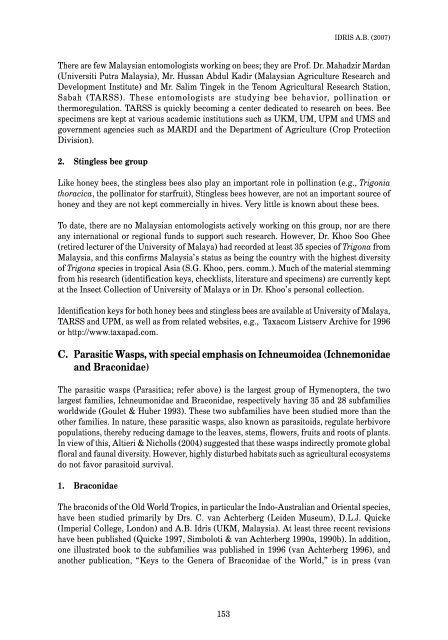o_19ko2dt161ng2j4e1tgnoqv1s45a.pdf
You also want an ePaper? Increase the reach of your titles
YUMPU automatically turns print PDFs into web optimized ePapers that Google loves.
IDRIS A.B. (2007)<br />
There are few Malaysian entomologists working on bees; they are Prof. Dr. Mahadzir Mardan<br />
(Universiti Putra Malaysia), Mr. Hussan Abdul Kadir (Malaysian Agriculture Research and<br />
Development Institute) and Mr. Salim Tingek in the Tenom Agricultural Research Station,<br />
Sabah (TARSS). These entomologists are studying bee behavior, pollination or<br />
thermoregulation. TARSS is quickly becoming a center dedicated to research on bees. Bee<br />
specimens are kept at various academic institutions such as UKM, UM, UPM and UMS and<br />
government agencies such as MARDI and the Department of Agriculture (Crop Protection<br />
Division).<br />
2. Stingless bee group<br />
Like honey bees, the stingless bees also play an important role in pollination (e.g., Trigonia<br />
thoracica, the pollinator for starfruit), Stingless bees however, are not an important source of<br />
honey and they are not kept commercially in hives. Very little is known about these bees.<br />
To date, there are no Malaysian entomologists actively working on this group, nor are there<br />
any international or regional funds to support such research. However, Dr. Khoo Soo Ghee<br />
(retired lecturer of the University of Malaya) had recorded at least 35 species of Trigona from<br />
Malaysia, and this confirms Malaysia’s status as being the country with the highest diversity<br />
of Trigona species in tropical Asia (S.G. Khoo, pers. comm.). Much of the material stemming<br />
from his research (identification keys, checklists, literature and specimens) are currently kept<br />
at the Insect Collection of University of Malaya or in Dr. Khoo’s personal collection.<br />
Identification keys for both honey bees and stingless bees are available at University of Malaya,<br />
TARSS and UPM, as well as from related websites, e.g., Taxacom Listserv Archive for 1996<br />
or http://www.taxapad.com.<br />
C. Parasitic Wasps, with special emphasis on Ichneumoidea (Ichnemonidae<br />
and Braconidae)<br />
The parasitic wasps (Parasitica; refer above) is the largest group of Hymenoptera, the two<br />
largest families, Ichneumonidae and Braconidae, respectively having 35 and 28 subfamilies<br />
worldwide (Goulet & Huber 1993). These two subfamilies have been studied more than the<br />
other families. In nature, these parasitic wasps, also known as parasitoids, regulate herbivore<br />
populations, thereby reducing damage to the leaves, stems, flowers, fruits and roots of plants.<br />
In view of this, Altieri & Nicholls (2004) suggested that these wasps indirectly promote global<br />
floral and faunal diversity. However, highly disturbed habitats such as agricultural ecosystems<br />
do not favor parasitoid survival.<br />
1. Braconidae<br />
The braconids of the Old World Tropics, in particular the Indo-Australian and Oriental species,<br />
have been studied primarily by Drs. C. van Achterberg (Leiden Museum), D.L.J. Quicke<br />
(Imperial College, London) and A.B. Idris (UKM, Malaysia). At least three recent revisions<br />
have been published (Quicke 1997, Simboloti & van Achterberg 1990a, 1990b). In addition,<br />
one illustrated book to the subfamilies was published in 1996 (van Achterberg 1996), and<br />
another publication, “Keys to the Genera of Braconidae of the World,” is in press (van<br />
153



